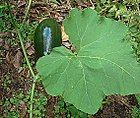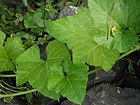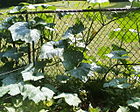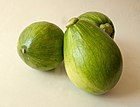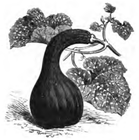Note: This is a project under development. The articles on this wiki are just being initiated and broadly incomplete. You can Help creating new pages.
Cucurbita moschata - Butternut
Squash is an annual climbing plant that can produce stems up to 5 metres long. These stems tend to sprawl over the ground, though they also climb into the surrounding vegetation where they support themselves by means of tendrils. The plant is widely cultivated, especially in warm temperate and tropical areas, mainly for its edible fruit, though it is also an important leaf vegetable in Africa, supplies a popular edible seed and has a wide range of medicinal uses.
Uses
Abdominal cramps, Intestinal worms, Tape worm, Reddish blotches, Haemorrhages, Jaundice, Headache, Ophthalmia, Kinds of tumours
Parts Used
Chemical Composition
The lipids isolated from the seeds included glycerides, sterol esters, phosphatidylcholine and phosphatidylinositol. [1]
Common names
| Language | Common name |
|---|---|
| Kannada | Sihi kumbala kaayi |
| Hindi | Halwa kaddu |
| Malayalam | Kumpalam |
| Tamil | Pucani |
| Telugu | Gummadi |
| Marathi | NA |
| Gujarathi | NA |
| Punjabi | NA |
| Kashmiri | NA |
| Sanskrit | |
| English | Butternut Pumpkin, Butternut Squash |
Properties
Reference: Dravya - Substance, Rasa - Taste, Guna - Qualities, Veerya - Potency, Vipaka - Post-digesion effect, Karma - Pharmacological activity, Prabhava - Therepeutics.
Dravya
Rasa
Guna
Veerya
Vipaka
Karma
Prabhava
Habit
Identification
Leaf
| Kind | Shape | Feature |
|---|---|---|
| Simple | Prostrate | Internodes to 10 cm, scabrous. Leaves 5-7-lobed, 16 x 24 cm, velvety, lobes acute; petiole to 15 cm |
Flower
| Type | Size | Color and composition | Stamen | More information |
|---|---|---|---|---|
| Unisexual | 8 cm wide | pale yellow | Stamens 3 | Flowers Season is June - August |
Fruit
| Type | Size | Mass | Appearance | Seeds | More information |
|---|---|---|---|---|---|
| Stamens 3 | 6 cm | Fruit oblong, contracted in the middle | seeds numerous, to 12 x 8 mm | {{{6}}} |
Other features
List of Ayurvedic medicine in which the herb is used
Where to get the saplings
Mode of Propagation
How to plant/cultivate
The plant can be grown from the temperate zone to the tropics, so long as there is a warm growing season of at least 150 days[3]
Commonly seen growing in areas
Photo Gallery
References
External Links
- Ayurvedic Herbs known to be helpful to treat Abdominal cramps
- Ayurvedic Herbs known to be helpful to treat Intestinal worms
- Ayurvedic Herbs known to be helpful to treat Tape worm
- Ayurvedic Herbs known to be helpful to treat Reddish blotches
- Ayurvedic Herbs known to be helpful to treat Haemorrhages
- Ayurvedic Herbs known to be helpful to treat Jaundice
- Ayurvedic Herbs known to be helpful to treat Headache
- Ayurvedic Herbs known to be helpful to treat Ophthalmia
- Ayurvedic Herbs known to be helpful to treat Kinds of tumours
- Herbs with Flowers used in medicine
- Herbs with Seeds used in medicine
- Herbs with Leaves used in medicine
- Herbs with Young stems used in medicine
- Herbs with Fruits used in medicine
- Herbs with common name in Kannada
- Herbs with common name in Hindi
- Herbs with common name in Malayalam
- Herbs with common name in Tamil
- Herbs with common name in Telugu
- Herbs with common name in English
- Habit - Climber
- Index of Plants which can be propagated by Seeds
- Herbs that are commonly seen in the region of Tropical area
- Herbs that are commonly seen in the region of South America
- Herbs that are commonly seen in the region of North America
- Herbs
- Ayurvedic herbs that don't have seed photos
- Cucurbitaceae

